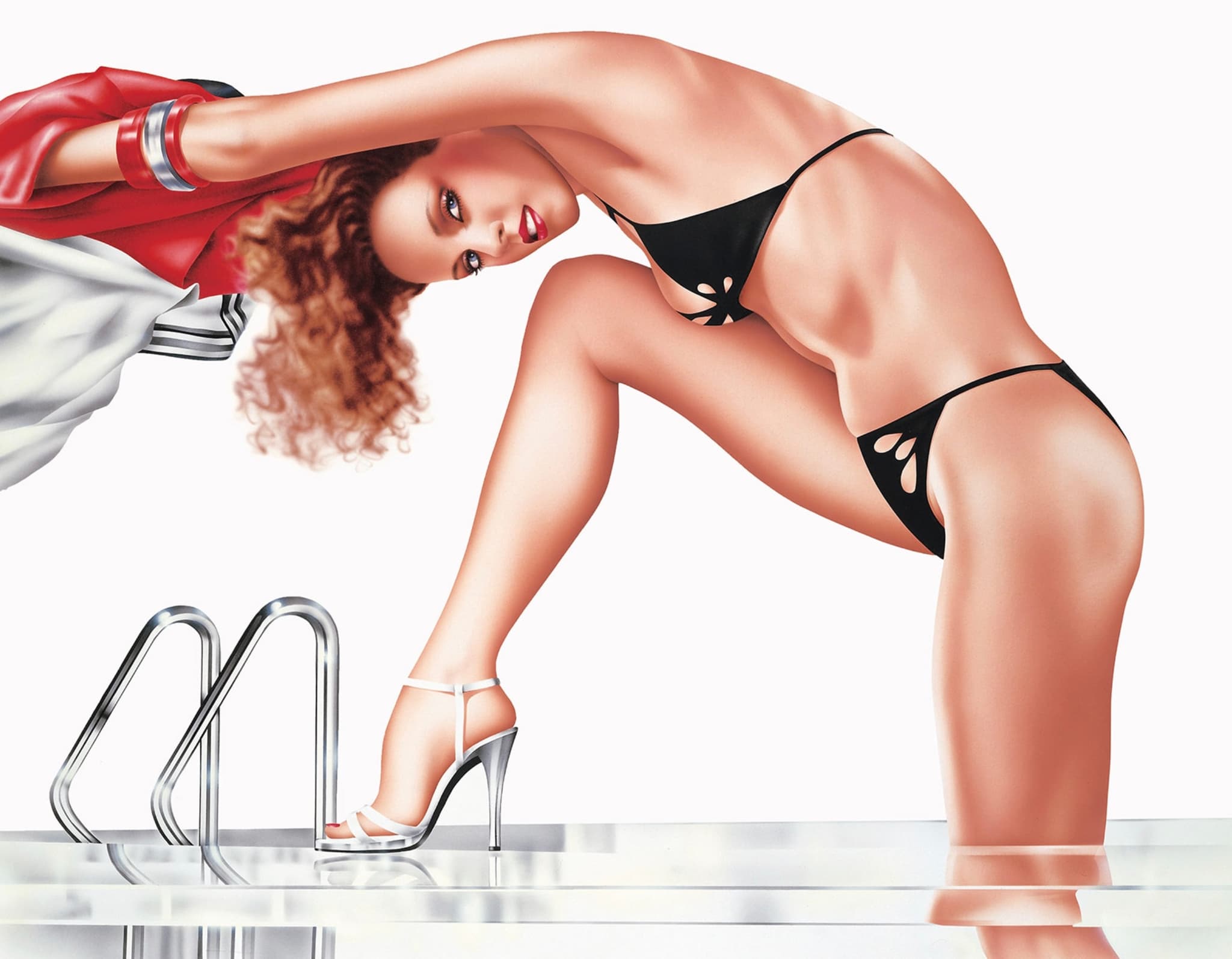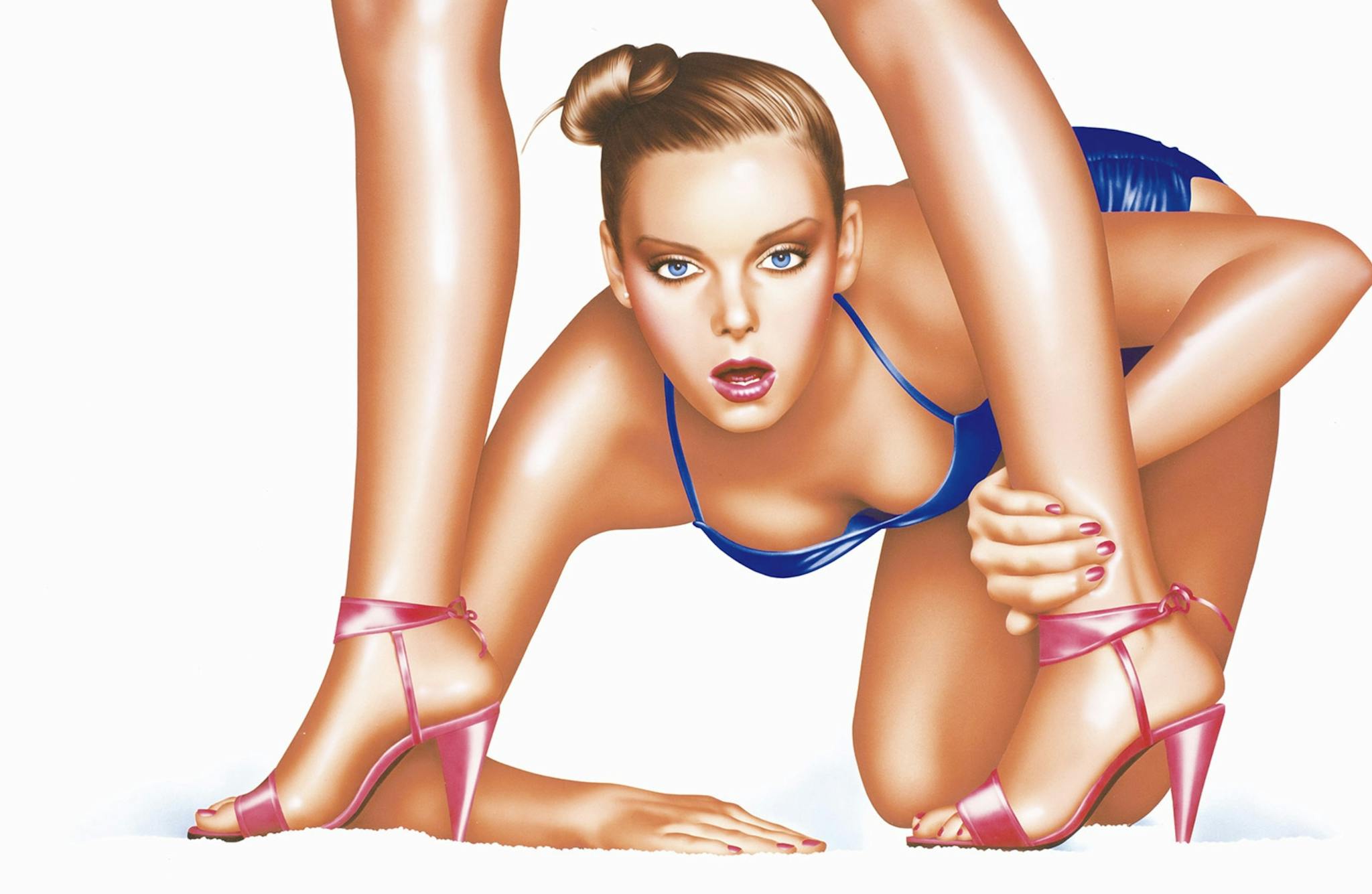Harumi Yamaguchi
April 2018
SEXY AND WESTERNIZED, THE WOMEN DEPICTED BY THE PIONEERING JAPANESE AIRBRUSH ARTIST ARE DESCRIBED BY FRANCESCA GAVIN AS ACTIVE, IRREVERENT AND EMPOWERED-EMBRACING THE PLAYFULNESS OF PIN-UP CULTURE AND REFLECTING A NEW WAVE OF FEMININITY EMERGING IN TOKYO.
Thinking about ideals of beauty feels almost quaint and dated at this point in time, but it's been a motivating force in art for centuries. When
Japanese artist Harumi Yamaguchi was creating her airbrush-painted pin-ups for commercial clients in the 1970s and '80s, conceiving an ideal icon of beauty was integral. The then thirty-something-year-old artist, now in her eighties, emerged at a moment when Japanese culture and female identity were in upheaval. Her girls were sexy and Westernized-and yet, despite these limitations, Yamaguchi's knowingly kitsch images somehow also presented a powerful vision of what women could be.
Part of what makes Yamaguchi's work so engaging is her favored technique: airbrushing. The medium is unusual in that there is no physical
connection between the artist and the surface itself; instead, paint is blown onto a surface by pressurised air. After its invention in the late 19th
century, the medium was adopted by a commercial context, used in 1930s advertising to define the streamlined look of art deco and streamline
moderne. Airbrushing echoed the fluid lines of cars, architecture and ideas around a mechanised, utopian future. It was also the print equivalent of the opulent musicals of Busby Berkeley or Fred Astaire-a hyper-real aesthetic that surpassed the human context of the era's economic depression.
Yamaguchi's work, however, owes more of a debt to the pin-up culture of the 1940s. The super-sexualised airbrush coquettes of Alberto Vargas
helped to define the decade. Vargas produced 180 paintings for Esquire magazine between 1940 and 1946, and worked for Playboy for sixteen years from 1959. The Peruvian artist painted translucent women: mainly Caucasian, often wrapped in transparent materials or wearing liquid-tight clothes. They were inviting, on display and sexy without being aggressive. Their flesh appears to explode from white backgrounds, their figures bursting from their seams like ammunition, toes always pointed, breasts always full. Yamaguchi took elements of these images but squeezed them through the sieve of slim, high fashion glamour.
Airbrushing was out of fashion by the 1960s, but in the early 1970s, there was a revival of the aesthetie, particularly amongst commercial artists
coming out of Los Angeles like Charlie White IlI, Peter Lloyd and Dave Willardson. It made sense conceptually in the wake of Pop artists like Mel
Ramos and Claus Oldenburg, who took the commercial and made it their subjects. Californian illustrators, however, approached airbrushing in a
very different way than Yamaguchi. Their work was retro, fatter, a visual version of the 1950s nostalgia rock musie that was then bubbling up. It was the ideal style for the poster for American Graffiti, George "Star Wars" Lucas' 1973 hit about teenage baby boomers cruising through small town America. Against this plump bumper car airbrushing, Yamaguchi's work felt contemporary, almost pioneering. A slimline, decidedly urban take on the medium.
When the Americans occupied Japan after World War II, they brought their ideal of beauty with them. The country's most famous airbrush artist,
Hajime Soravama, was upfront about the influence of Western pin-ups on his work. Born in 1947, six years before Yamaguchi, Soravama's work was emblematic of a period when Western influence on Japan exploded. When Sorayama graduated from Tokyo's Chuo Art School in 1968, airbrushing was considered dated and kitsch. It wasn't until the early 1980s that his pornographic images began to reach a global audience.
Drawing directly from BDSM subcultural fantasies, with all the elements of submission and violence built into those fetishes, Sorayama's work fused the mechanoid with the female body into unreal pin-ups he called "gynoids." Speaking of his work in the 1990s, however, he placed his characters within the legacy of feminism. He saw his women as powerful, not submissive. Sorayama's work differs from Yamaguchi in numerous ways. First, he was man and Yamaguchi was a woman, which created a huge difference in how their female characters were depieted. Yamaguchi's girls are sexy but active: though often in states of undress, they remain playful. They are often depicted in movement, like the figures in 1980s tampon ads, always ready to throw on a pair of roller skates. Soravama, like Giger, mixed the body and the machine. The eroticism was violently present in his work.

Yamaguchi's subjects, meanwhile, are young, progressive working girls, embodying more than mere erotie fantasies. This in part reflects the fact that Yamaguchi's work was made for a commercial context. For example, many of her pieces were made as illustrations for Tokyo's PARCO department store. The shop harnessed the idea of social changes within an economic, capitalist context. Yamaguchi created images of the girls PARCO shoppers wanted to be. The audience was largely young, female and increasingly economically independent. Yamaguchi herself was her audience: a freelance illustrator with friends in the feminist uman ribu (women's lib) movement.
Harumi's girls were high fashion and stylized, not unlike the contemporary photographic work of Guy Bourdin or Helmut Newton. Her girls could
have easily slipped into the pages of Vogue amongst ads for Charles Jourdan shoes or David Bailey photographs of Jerry Hall. She depicted a world of shoulder pads, frills, metallic fabrics, hats and stripy bikinis. Her colour palette reflects the 1970s and 1980s vibrancy of a new wave of femininity lots of pop pink and blue, gold and reflective pleather.
The artist's approach to skin is also interesting. Heavy on the contour, Yamaguchi's girls are hard. Their bodies are almost mirror-like in their
reflectiveness. The results are essentially seductive. American artist Patrick Nagel, who like Vargas also created illustrations for Playboy, is another interesting parallel for Yamaguchi. The designer who created the cover for Duran Duran's graphic album Rio in 1982 was the pinnacle of early '80s glamour. Nagel and Yamaguchi shared a commercial sense of fashion mixed with ideas of reinventing the contemporary pin-up.

Yamaguchi had no problem with creating images of women displayed for consumption. Alongside her advertising work, Yamaguchi also tackled
nudes. These pieces depicted fleshier women, a hyper-realist update of Tamara Lempicka. In these works, the women are turned away from the
viewer, the skin on their backs and buttocks a perfect cream. In many ways, they look like Ingres' exotic figures, where nude bodies are twisted so their assets are displayed from the canvas. They look out with side eyes. They don't appear to be troubled by their beauty.
Though these pictures sit firmly in a retro '80s aesthetic, they seem to resonate with the reflective, surface nature of contemporary culture. London space Project Native Informant and New York gallery Bridget Donahue have each exhibited the pieces, alongside shows in Tokyo including a major show at PARCO itself. Perhaps, like the revived work of Ettore Sottsass and Memphis, the playful camp images feel less cloying and superficial today. Perhaps the boundaries between design, graphics and fine art are no longer as firm. And yes, they pop on Instagram, but
ultimately, this is work that does more than beautifully depict surface-it delves into the idea of surface and tears it apart.